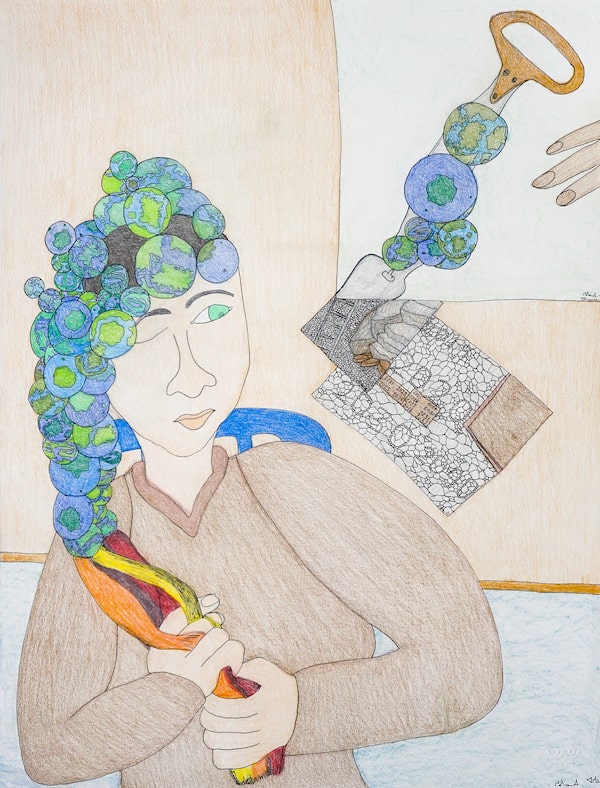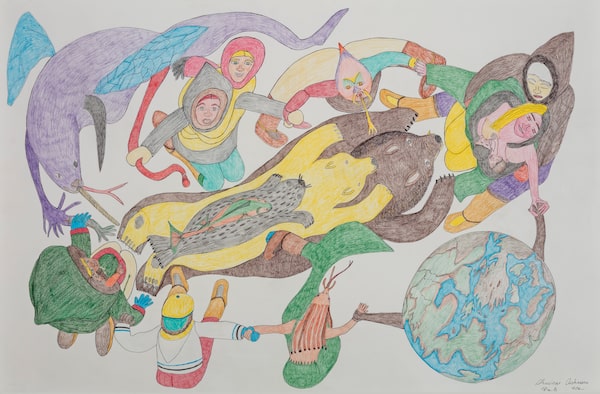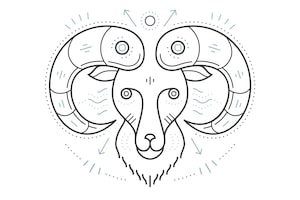
Shuvinai Ashoona at a January exhibition opening at Feheley Fine Arts in Toronto.Feheley Fine Arts
Amidst the bustle of a Toronto gallery preview of her new work, artist Shuvinai Ashoona takes a moment to recall how she started. It was about 30 years ago, at her younger sister’s house in Cape Dorset, the Nunavut community renowned for the prints produced by the local co-op. She had drawn a picture on a small sheet of paper and her sister seized on it. “My sister encouraged me [saying] ‘Hey, you don’t do anything, you don’t make money. All you are thinking is welfare or something like that.’ She told me to keep going: ‘Take it down to the co-op and try to get some money out of it. Maybe you’ll succeed.’”
And succeed she did. Today, Ashoona is a Canadian art star. She is the subject of a career retrospective at Toronto’s Power Plant gallery this winter; she recently won the $50,000 Gershon Iskowitz Prize for a mid-career Canadian artist, and she is recognized internationally. Canadian curators celebrate her idiosyncratic drawings combining images of contemporary Inuit life with phantasmagorical shamanic creatures and pop-culture elements. And collectors snap them up: Her commercial show at Feheley Fine Arts in Toronto had mostly sold out on its opening weekend.

Braiding Worlds by Shuvinai Ashoona. A third-generation artist, Ashoona is recognized internationally.Feheley Fine Arts
Ashoona is part of a bubbling ferment in Inuit culture. Her recent visit to Toronto coincided with the Qaggiavuut troupe’s production of Kiviuq Returns, a stage show in Inuktitut at the Tarragon Theatre, and followed last fall’s nomination of throat singer Tanya Tagaq’s fictionalized memoir, Split Tooth, to the Giller Prize long list. Meanwhile, Isuma, the film and video collective helmed by Zacharias Kunuk, the pioneering director of Atanarjuat: The Fast Runner, and Montreal producer and cinematographer Norman Cohn, will be representing Canada at the Venice Biennale in May. It will be the first time Inuit artists have been invited to program the Canadian pavilion at the festival known as the Olympics of visual art.
And yet, Ashoona, a third-generation artist, is also one of a dwindling rank whose prints and carvings first fixed the image of Inuit art in the South as traditional work stuffed with pleasing motifs of Arctic owls, polar pears and mothers in parkas. Her drawings, mixing images from her television set with more traditional elements, mark the moment of a tricky evolution for the visual arts of the Arctic from ethnographic product to rarefied contemporary practice. “These are living contemporary Canadian artists that should be at the Power Plant not in the basement of the National Gallery, which 20 years ago was where you would find Inuit art,” says curator Nancy Campbell, who organized the Power Plant show. Today, Cape Dorset is increasingly known as Kinngait and its art has moved far beyond owls.
Inuit visual art traditions – carved amulets, decorative needlework, finely detailed tattoos – are prehistoric, dating back long before contact with Europeans. Carvings were developed as trade goods in the 19th-century but the 20th-century manifestations, big sculptures and graphic prints, were mainly an economic project encouraged by government agents: As the Inuit were forced into permanent settlements in the 1950s, they needed cash. After a successful sale of carvings in Montreal in 1949, government administrator and artist James Houston hit on printmaking as a medium to translate Inuit motifs into marketable art and briefly studied in Japan to perfect the techniques he introduced to Cape Dorset. Artists would bring their drawings to the studio where trained local printers could transfer them to plates, adapting the skills once used incising bone or making needlework to stonecut or etching. Houston’s wife, Alma, marketed the art and collectors warmed to the traditional imagery. Artists such as Jessie Oonark and Kenojuak Ashevak, whose owls have adorned stamps, a coin and a banknote, became beloved national figures. As a job-creation exercise, the printmaking was successful and, as Ashoona’s sister’s advice suggests, the work was valued for the income it brought in.
Inuit filmmaker Zacharius Kunuk, who has made a documentary about climate change from the perspective of Inuit elders, is photographed in Toronto Ont. Oct. 13, 2010.Kevin Van Paassen/The Globe and Mail
“It is all about feeding your families up there,” said Pat Feheley, whose Toronto gallery shows Ashoona. In a recent book about the artist, Campbell says she is the key wage earner for a large extended family. Such economics may have led curators in the South, in an era when a hierarchy of fine art over craft was unquestioned, to perceive Inuit art as a lesser genre, but it didn’t dampen the market. At the height of the printmaking boom in the 1960s and ’70s, a half-dozen Inuit co-ops scattered across the Arctic released annual collections of prints by multiple artists. But the co-ops depended on government grants and when those dried up in the 1980s, printmaking languished. Today, only Cape Dorset’s Kinngait Studios, the longest-running professional printmaking studio in Canada, has continued with annual releases; the output from Baker Lake, once a thriving centre, and Pangnirtung has been erratic in recent years, and some critics have been dismissive of the quality that results.
“One of the things that bothers me the most right now is that there is only Dorset in terms of visual artists,” Feheley said. “If you are talented and live in Pond Inlet and want to draw, first of all, how do you get good drawing paper and coloured pencils? Second, who do you take it to? Who’s there to encourage you?”
Feheley recently returned from Ulukhaktok, NWT (formerly Holman), where she is part of a team working to reopen a print shop in the western Arctic. The Holman studio has not offered prints since 2000 and the relaunch, funded by the Canada Council, will give several artists a year to experiment with media before any work is released.

Scenes of pregnant women giving birth to blue-and-green globes by Ashoona is an almost utopian vision of a reckoning between the natural and human realms.Shuvinai Ashoona/Private Collection

Canadian curators celebrate Ashoona's idiosyncratic drawings combining images of contemporary Inuit life with phantasmagorical shamanic creatures and pop-culture elements.Toni Hafkenscheid/Handout
The project is important because Inuit visual art needs to raise a new generation after the deaths of both elders and members of the middle-aged “brat pack” that had turned to new iconography. The death of Ashoona’s cousin, the innovative Annie Pootoogook, whose body was found in the Ottawa River in 2016, was just the most tragic in a string of losses in the art-making dynasties. Her uncle Kananginak Pootoogook had died of cancer in 2010; the revered Ashevak died in 2013; Ashevak’s nephew Tim Pitsiulak died of pneumonia in 2016, aged only 49.
Feheley is looking at the work of younger Cape Dorset artists such as Ooloosie Saila, who is only 28, but it’s not clear the new generation will turn to printmaking. It was drawing that revolutionized Inuit art in the 1990s and 2000s after William Ritchie, manager of Kinngait Studios, introduced larger paper.
“Inuit art was viewed as a product, but I’m not interested in product. I want people to say what they want to say and not just bang out a bunch of owl prints,” Ritchie said. Annie Pootoogook became celebrated for realistic and sometimes painful contemporary scenes, while Ashoona’s art exploded into large drawings that drew from multiple sources. She has included images of the Titanic, a tragedy she knows from her favourite movie, and scenes of pregnant women giving birth to blue-and-green globes in almost utopian visions of a reckoning between the natural and human realms.
At first, buyers viewed such work with suspicion – where were their prints of bears and birds? – but today, drawings are prized and have helped engage a younger generation of collectors. Gradually, the south is making less and less distinction between an Inuit artist and a southern one.
Director Zacharias Kunuk, left, and co-director and actor Natar Ungalaaq, right, poses for a photo to promote their new movie Maliglutit, which takes in Nunavut and has an all-Inuit cast, during the Toronto International Film Festival on Sept. 12, 2016.The Canadian Press
One breakthrough occurred in 2009, when Campbell paired Ashoona with Toronto artist Shary Boyle, that creator of feminist sprites and disruptive fairies, for an exhibition at the University of Toronto. “When I saw Shuvinai really starting to blow it out and getting away from scenes of Cape Dorset and doing things that would never sell, I thought of Shary Boyle. It was an experiment,” Campbell says. Today, nobody puts Inuit art in the basement: At the National Gallery of Canada in Ottawa, the postwar section of the Canadian and Indigenous galleries juxtaposes Inuit sculptures and prints with the work of Quebec abstractionists such as Paul-Émile Borduas in a bold conversation between North and South.
One difference, however, remains: Inuit art is cheaper. Ashoona’s prices are less than half what a comparable southern artist would charge, raising the worrying possibility that she and her community aren’t fully benefiting from her rising star. The Inuit market is significantly different, partly because it uses a co-op system. The West Baffin Eskimo Cooperative, as it has been called for all of its 60 years, sets prices, shares profits around and pays the artists upfront. Also, the prints and drawings are produced in large quantities, which keeps prices lower. Inuit art has always been affordable, which has been part of its attraction, but some artists are concerned about the price gap. In a 2017 image of construction equipment, Cape Dorset artist Padloo Samayualie jokingly replaced a small sign on a vehicle with one asking the viewer to pay more money for her drawings.
In her early 40s, Samayualie has also trained in animation, part of a gradual movement in the North toward new media, even though bandwidth is still in short supply.
“[Art] is shifting but it is not dying out,” says Darlene Coward Wight, curator of Inuit art at the Winnipeg Art Gallery, which will open a new centre devoted to its extensive Inuit art collection in 2020. “The younger artists are not cutting themselves off from traditional culture.”
A scene from Kunuk's recent historical drama Maliglutit: The Searchers.
The filmmaker Kunuk is one veteran who has worked particularly hard to keep traditional knowledge alive. Ironically, he comes from Igloolik, a community that voted to keep out TV in the 1970s, but he has helped establish IsumaTV, an online platform that now hosts thousands of Indigenous videos. Meanwhile he and Cohn have also created sweeping historical dramas such as 2002’s prize-winning Atanarjuat and more recently Maliglutit: The Searchers (2017), as well as shorter projects that document aspects of traditional life, such as a 2017 multiscreen video installation that recreated a dog-sled race. This approach, rapidly adapting southern media to tell traditional stories and explore an Inuit iconography, is typical of the flexibility that has always characterized the art.
Come May, in the idiosyncratic space of the Canadian pavilion in the Biennale gardens, Isuma will be presenting recent work, including a new fiction film, in an immersive installation. Meanwhile, Ashoona has returned to Cape Dorset, settling back into art-making that looks out to the world.
The survey of work by Shuvinai Ashoona continues at the Power Plant until May 12. Her work is also on view at Feheley Fine Arts to Feb. 23.




 Kate Taylor
Kate Taylor